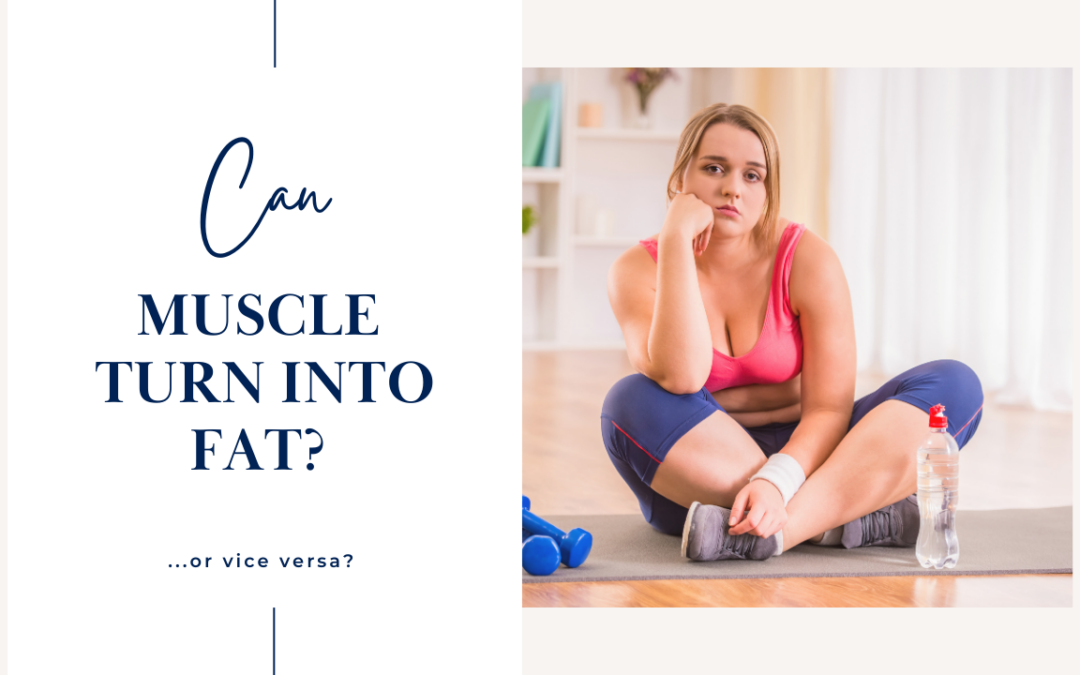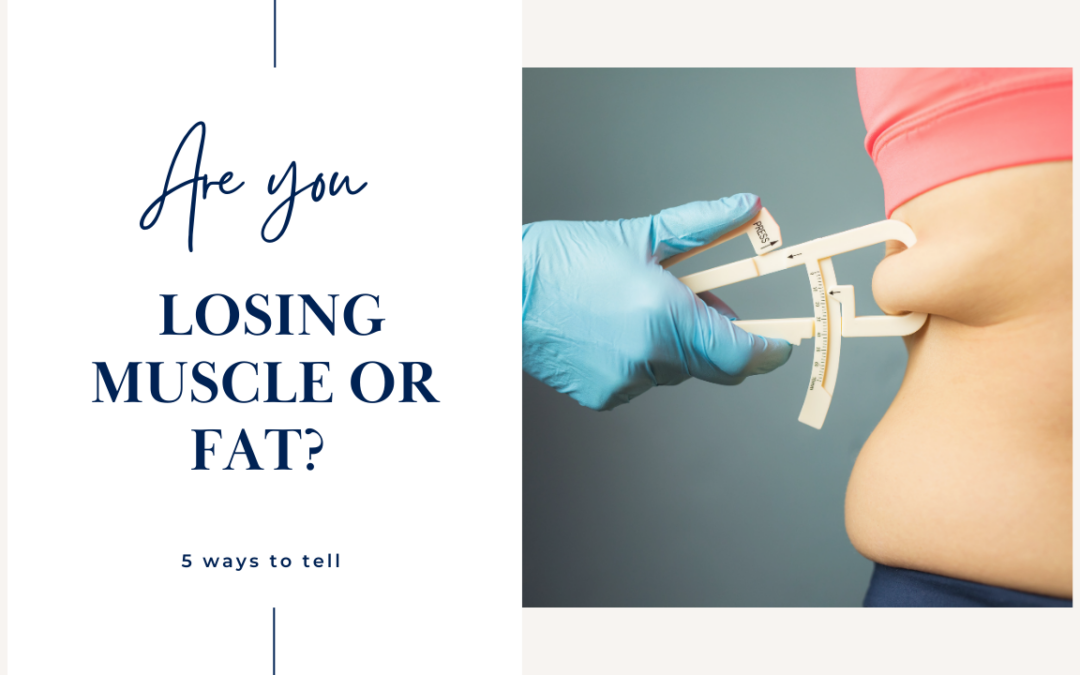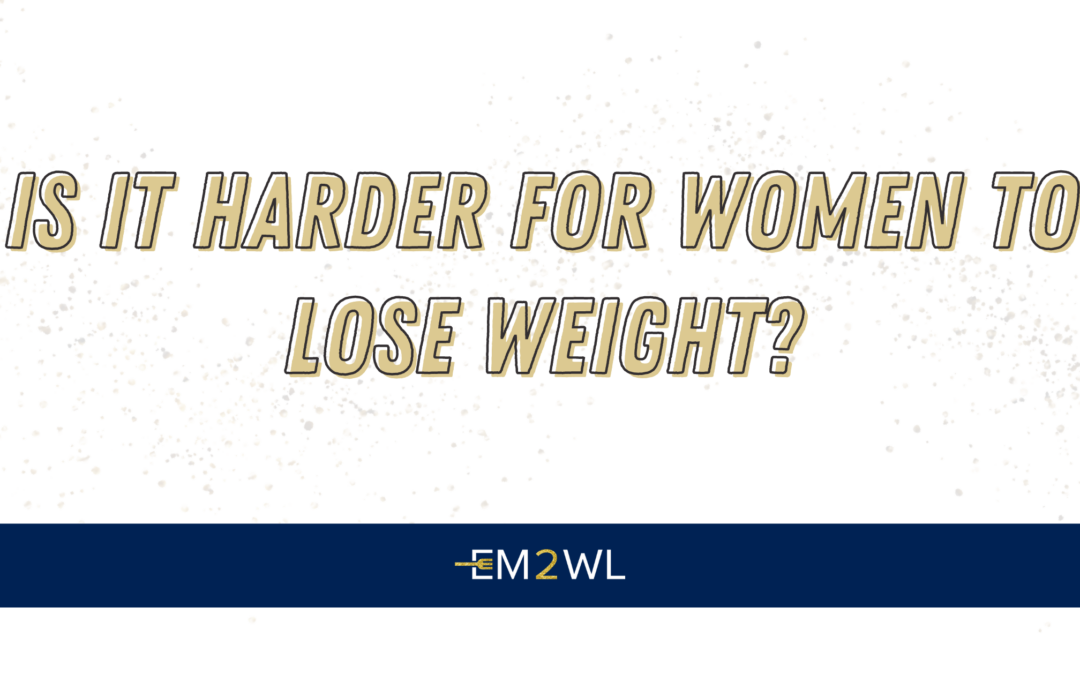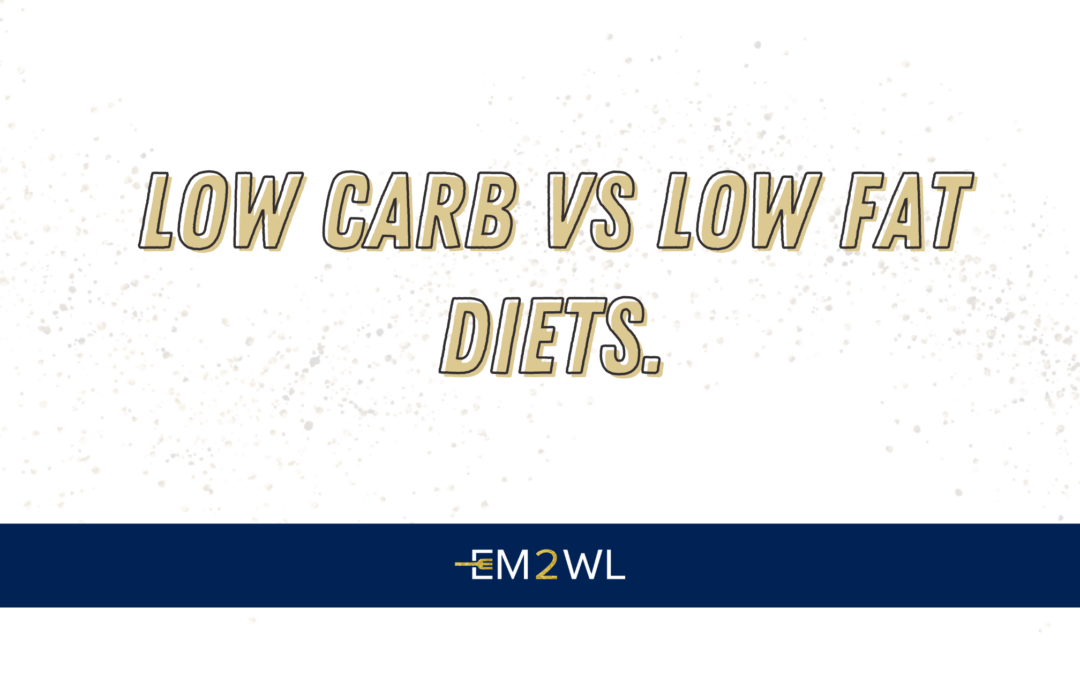
by EM2WL | Jun 21, 2023 | Consistency, Fat Loss / Cutting, Nutrition, Troubleshooting
 Simplify Your Weight Loss Journey
Simplify Your Weight Loss Journey
If you listen to the media, fat loss can sound pretty complicated. High carb, low carb, nutrient timing, intermittent fasting, carb cycling, ketogenic diets, carb backloading, juicing, green smoothies, magical supplements…
It can be challenging to keep a level head and avoid all the latest trends, wondering if a tweak (or two) might be a way to break out of a plateau or to get better results. There are definitely times to include a tweak, but generally speaking, its best that you save these for times that you really need them.
So how do you know if its time to include a tweak?
At EM2WL, we encourage you to take a very no-nonsense, simplified approach to fat loss with minimal rules. Instead of spinning your wheels to figure out which diet is best — take a moment to strip away the “nonsense” from various diet plans that are often just minute variations on the basics. There are a few best practices that we believe to be critical to your success. It’s best to make sure that these elements are firmly in place before tweaking anything.
Think about building a successful fat loss program like building a house. When building a house, you wouldn’t want to try putting up walls before the basic foundation has been laid. Without a firm foundation to build upon, everything else is pretty useless.
What makes up the foundation of a successful fat loss program? We believe there are four key components that are critical to have well established before incorporating any other “tweaks.” We recommend looking over your current fat loss plan and evaluating whether you have a good handle on the following four elements before making any additional changes. How do you measure up?
1. Sufficient calorie intake
 If you’ve been following EM2WL for some time, you know that we firmly believe that eating enough is a key component of a successful fat loss plan. The standard “eat less, exercise more” model of weight loss can lead to more muscle than fat loss, lowering your metabolic rate over the long term. Without eating enough calories, you run the risk of causing metabolic damage which does more harm than good. If you’ve been dieting for a very long time and are not seeing the results that you desire, it is very likely that you would benefit from doing a metabolic reset. If you are still struggling to get in an appropriate number of calories daily, it is highly recommended that you become consistent there before incorporating any additional changes. If you’re curious about how many calories is considered sufficient, check out our calorie calculator.
If you’ve been following EM2WL for some time, you know that we firmly believe that eating enough is a key component of a successful fat loss plan. The standard “eat less, exercise more” model of weight loss can lead to more muscle than fat loss, lowering your metabolic rate over the long term. Without eating enough calories, you run the risk of causing metabolic damage which does more harm than good. If you’ve been dieting for a very long time and are not seeing the results that you desire, it is very likely that you would benefit from doing a metabolic reset. If you are still struggling to get in an appropriate number of calories daily, it is highly recommended that you become consistent there before incorporating any additional changes. If you’re curious about how many calories is considered sufficient, check out our calorie calculator.
2. Protein
Not only do most women typically not take in enough calories, but tend to be lacking in the protein department as well. This macronutrient can be one of your biggest weapons in winning the fat loss game! Generally, we recommend taking in about 0.8 to 1.0 grams of protein per pound of body weight. A number of studies have shown numerous benefits to high-protein diets. Since protein takes longer for the body to break down and digest, it promotes a feeling of fullness, making it easier for you to stick to your plan. Protein also is essential in sustaining your lean mass, helping you to recover from workouts, and maintaining healthy skin, nails and organs. Protein also has been reported to improve brain function, lower blood pressure and improve sleep quantity.
It can be very challenging to get in all that protein! Give yourself time to get acclimated to a higher protein diet by setting reasonable goals and increasing them weekly. For instance, if your goal is to eat 150 grams of protein, but you’re currently averaging around 75 grams daily, you might start by trying to get in just 100 grams daily and increase slowly. Divide your protein among your meals, and it will likely seem a bit more manageable. Focus on making sure to hit your protein target daily, and then allocate the remaining calories to carbohydrates and fats.
3. Fiber
Most Americans only average about 15 grams of fiber daily, while most people should be taking in anywhere from 20 to 30 grams of fiber daily. Foods high in fiber are more filling and generally take longer to eat than foods low in fiber. They are a great way to “stretch out” your meals, thereby eating a high volume of food without adding many calories. In addition, including fiber in your diet will slow the digestion of carbohydrates and absorption of sugars, keeping blood sugar stable. High fiber foods also promote digestive health and prevent problems like constipation, hemorrhoids, IBS, and other digestive complaints. High fiber diets also promote heart health by moving fats and bile salts out of the body, lowering cholesterol in the process.
Tip: Keep an eye out for snacks like Quest Bars which can provide 20g of protein, and 17g of fiber per serving. They can be helpful to reach your goals in a pinch, or if you’re newer to tracking these macros, but be sure to try getting as much protein and fiber from whole food sources as possible.
4. Heavy Resistance Training
Heavy resistance training should be a key component of any fitness program when the goal is fat loss. Heavy resistance training has a number of metabolic benefits that will pay off in the fat loss department. Unlike cardio, the metabolic benefits of this type of training last for 24-48 hours after completing your workout as your body must work harder to rebuild its oxygen stores. This effect, commonly referred to as the afterburn effect or EPOC (post-exercise oxygen consumption) has a number of metabolic and athletic benefits that will improve your body composition as well as your gym performance! If you don’t know where to start, there are a number of strength training programs to get you started on your journey to a leaner, stronger, healthier you!
 If your current fitness program does not currently involve heavy resistance training at least 2-3 times a week, it is highly recommended that you start here before adding in cardio or other forms of exercise to accomplish your goals. You will be amazed at the way your body transforms when you consistently hit the weights!
If your current fitness program does not currently involve heavy resistance training at least 2-3 times a week, it is highly recommended that you start here before adding in cardio or other forms of exercise to accomplish your goals. You will be amazed at the way your body transforms when you consistently hit the weights!
DISCLAIMER: We know that many of our followers love running and other forms of cardio and we firmly believe that you should regularly engage in a form of exercise that you truly enjoy! However, there may be times to evaluate whether your preferred form of activity supports your goals.
The Take Away Message
If you feel that you have a good handle on these four elements, there is absolutely nothing wrong with making a small change or two to see how your body responds. We emphasize that it is usually best to change one thing at a time and give your body a chance to respond before changing another variable, however. As you make adaptations to your plan, you will want to make sure you are listening to your body! Pay attention to how you look and feel, how you are performing in the gym and your energy level any time you make a change. Often times, just a very small change can lead to some great results, but if you change too many things at once you will never know what that missing part of the puzzle was!
Photo credit: Apolonia, hin255 of www.freedigitalphotos.net

by EM2WL | May 17, 2023 | Building Muscle, Fat Loss / Cutting
Can muscle turn into fat (or vice versa)? Technically…no. But it can sometimes look like it. This illusion is precisely why most women spend less than 5% of their weight loss efforts trying to build muscle, and over 95% (spinning their wheels!) trying to tone it. Today, we’re setting the record straight about why this simply isn’t possible and how having outdated beliefs about muscle and fat being interchangeable ends up causing more problems for 40+ women than it provides solutions… (full video below)
Understanding Body Composition
Before we dive into the myth, let’s take a moment to understand the characteristics of muscle and fat. Muscle tissue is composed of protein filaments and is responsible for movement, strength, and endurance. On the other hand, fat tissue serves as an energy storage depot, storing excess calories in the form of triglycerides.
The Distinct Nature of Each
Each cell is distinct in their composition and function. Muscle cells contract to produce force, allowing movement, while fat cells store energy as triglycerides. These two tissues have different structures, purposes, and metabolic activities, making it impossible for muscle to transform into fat or vice versa.
Weight Loss and Changes in Body Composition
During weight loss, it’s common to experience changes in muscle mass and fat stores. However, it’s crucial to understand that these processes are separate and not interconvertible. A calorie deficit can lead to overall weight loss, but if not managed properly, it can result in loss of muscle and potential gain in bodyfat. Proper nutrition, exercise, and a balanced approach to weight loss are key to preserving lean body mass while reducing fat.
Factors Influencing Muscle Loss and Bodyfat Gain
Several factors can contribute to muscle loss and fat gain. Inadequate protein intake, lack of strength training exercises, and prolonged calorie deficits can lead to muscle breakdown. On the other hand, excess calorie intake, reduced physical activity, and an imbalanced diet can contribute to fat gain. By addressing these factors, we can maintain muscle mass and promote a healthier body composition.
Preserving Muscle and Reducing Bodyfat
To preserve lean body mass and reduce bodyfat effectively, it’s important to adopt specific strategies. Engaging in regular strength training exercises helps to maintain and build muscle mass. Consuming an adequate amount of protein is crucial for muscle growth and repair. It’s also essential to create a moderate calorie deficit that supports fat loss while minimizing muscle loss. Finding a sustainable approach to nutrition and exercise is key to achieving long-term success.
Conclusion: Muscle cannot turn into fat, and fat cannot turn into muscle. They are distinct tissues with different structures and functions. By debunking this myth, we aim to empower individuals to make informed decisions about their fat loss journey. Remember, preserving muscle mass, reducing bodyfat, and achieving a balanced body composition require a combination of proper nutrition, regular exercise, and a sustainable approach.

by EM2WL | Apr 14, 2023 | Fat Loss / Cutting, Troubleshooting
When it comes to weight loss, it’s important to remember that losing weight doesn’t always mean losing fat. In fact, if you’re not careful, you may end up losing muscle instead. Losing muscle mass can slow down your metabolism and make it more difficult to maintain your weight loss over time. In this post, we’ll explore five signs that you may be losing muscle instead of fat, and provide tips to help you preserve muscle mass and achieve your fitness goals.
#1 You’re Losing Weight Too Quickly
Losing weight too quickly can be a sign that you’re losing muscle mass. When you lose weight too quickly, your body may start breaking down muscle tissue for energy, which can slow down your metabolism and make it more difficult to maintain your weight loss over time. Aim to lose no more than one to two pounds per week to ensure that you’re losing fat, not muscle.
Key Takeaway: While losing weight quickly may seem like a good thing, it could be a sign that you’re losing muscle instead of fat. Slow and steady wins the race when it comes to weight loss!
#2 You’re Not Engaging in Strength Training
If you’re not engaging in strength training exercises, you may be losing muscle mass. Strength training exercises help to build and preserve muscle mass, so it’s important to incorporate them into your workout routine. Aim to strength train at least two to three times per week to help preserve muscle mass and maintain strength.
Key Takeaway: If you’re not strength training, you may be missing out on an important component of weight loss. Incorporating strength training exercises into your routine can help preserve muscle mass and maintain strength.
#3 Your Diet is Too Restrictive
If you’re following a very restrictive diet, you may be losing muscle mass. Restrictive diets can be low in calories and protein, which are both important for preserving muscle mass. It’s important to consume enough protein and calories to support muscle growth and repair.
Key Takeaway: While following a restrictive diet may seem like a good way to lose weight quickly, it could be causing you to lose muscle mass instead of fat. Don’t forget to consume enough protein and calories to support muscle growth and repair.
#4 You’re Feeling Weaker
If you’re feeling weaker than usual, it may be a sign that you’re losing muscle mass. Muscle mass is directly tied to strength, so if you’re losing muscle mass, you may also be losing strength. This is usually amplified with #2 and #3 are out of whack. Yet another reason why it’s so important to keep calories as high as possible and continue to strength train even when dieting.
Key Takeaway: Feeling weaker than usual could be a sign that you’re losing muscle mass. Don’t let your strength suffer – make sure you’re eating enough calories to sustain the level of activity that you are engaging in while incorporating a periodized strength training routine to help preserve muscle mass and maintain strength.
#5 Your Body Composition Isn’t Changing
Finally, if your body composition isn’t changing, it could be a sign that you’re losing muscle mass. While you may be losing weight overall, you may not be losing fat in the right places. Losing muscle mass can cause your body to lose shape and become less toned.
Key Takeaway: If you’re not seeing changes in your body composition, it could be a sign that you’re losing muscle mass. Don’t let your hard work go to waste – make sure you’re preserving muscle mass and losing fat in the right places.
If you’re trying to lose weight, it’s important to make sure you’re losing fat, not muscle. By paying attention to these five signs and incorporating strength training exercises into your routine, you can help preserve muscle mass and achieve your weight loss goals in a healthy and sustainable way.

by Keysia Linares Marzullo | Oct 7, 2022 | Diet Mentality, Fat Loss / Cutting, Podcast, Q & A, Uncategorized
Is It Harder For Women To Lose Weight Than Men?… The age-old question.
Yes. It’s not your imagination.
The female fat loss struggle is REAL.
If you’re anything like me, you’ve had at least one experience of spending an inordinate amount of time recruiting a male accountability partner (“hey, let’s do this diet together…please…please”) – only to end up frustrated when he finally agrees and seems to get ALL the results.
Sure, you start off strong and have WAY more willpower, but eventually, you hit a plateau, and he…doesn’t. Of course, this is an oversimplification of gender (not all men lose fat super easily), but men definitely have a few advantages over us.
This podcast discusses the five reasons why fat loss is harder for women.
Here’s a sneak peek into today’s episode…
> [1:30] 5 Reasons Why It’s Harder For Women To Lose Weight
> [2:12] #1 Focus on the Scale
> [5:25] #2 Hormones
> [9:29] #3 Muscle
> [12:36] #4 Diet Preferences
> [17:17] #5 Patience
Click Here to Listen To This Week’s Podcast
About The Diet Rebel Podcast
If you are a woman who hates having to choose between loving your body and changing it, this podcast is for you. In this podcast, we talk about everything from loving your body exactly as it is now to becoming the fittest, leanest, and tonest you’ve ever been – no matter HOW old you are, how many tiny humans you’ve birthed, or how many times you’ve lost & regained the same (15 or 50!) lbs! Seriously, you don’t want to miss it! So grab a snack, preferably protein based (lol), sit back and enjoy the Diet Rebel podcast. Brought to you by Eat More 2 Weigh Less @ eatmore2weighless.com
To support The Diet Rebel Podcast with Kiki Smith, make sure to follow, download, and share the podcast with your family and friends! Enjoy!

Links
Download Your FREE Quick Start Guide
Sign Up For The FREE Women’s Fat Loss Webinar
SUBSCRIBE To Our Youtube Channel
Download our Workout App

by Keysia Linares Marzullo | Sep 25, 2022 | Diet Mentality, Fat Loss / Cutting, Podcast, Q & A, Uncategorized
Low Carb vs. Low Fat and how to determine which one is best for you. Is there even a reason why you have to choose in the first place? I guess we will see as we talk about this in today’s podcast episode.
Low carb today is what low fat was in the nineties. We keep resurrecting many identical diets over and over, and low carb has come in so many variations, from Atkins to Keto. Hence, there are different ranges of what people consider “low carb,” from no carb to low carb and anywhere in between. Many people are wondering if that is a route they should take and in this podcast, you get to listen in on a previous Q&A with my clients we break down the details to help you decide.
Here’s a sneak peek into today’s episode…
> [0:40] Why Do You Have To Choose?
> [3:55] Protein is Non-Negotiable
> [4:41] Fat or Carbs?
> [7:05] #1 Taste Preference
> [10:09] #2 Calorie Deficit Preference
> [13:32] What’s Best For You?
Click Here to Listen To This Week’s Podcast
About The Diet Rebel Podcast
If you are a woman who hates having to choose between loving your body and changing it, this podcast is for you. In this podcast, we talk about everything from loving your body exactly as it is now to becoming the fittest, leanest, and tonest you’ve ever been – no matter HOW old you are, how many tiny humans you’ve birthed, or how many times you’ve lost & regained the same (15 or 50!) lbs! Seriously, you don’t want to miss it! So grab a snack, preferably protein based (lol), sit back and enjoy the Diet Rebel podcast. Brought to you by Eat More 2 Weigh Less @ eatmore2weighless.com
To support The Diet Rebel Podcast with Kiki Smith, make sure to follow, download, and share the podcast with your family and friends! Enjoy!

Links
Download Your FREE Quick Start Guide
Sign Up For The FREE Women’s Fat Loss Webinar
SUBSCRIBE To Our Youtube Channel
Download our Workout App

by Keysia Linares Marzullo | Sep 16, 2022 | Diet Mentality, Fat Loss / Cutting, Podcast
Most of us are blown away when we learn the shocking truth that cardio is not the be-all-end-all of fat loss. It can take some time to fully wrap our heads around the concept (especially if you’re the type who actually ENJOYS it and can’t imagine life without it). Not surprisingly, one of the questions we receive most often in the early stages of discovering EM2WL is: “OK. So, where exactly does cardio fit? How much cardio can/should I do? In this podcast, I’m going to share with you The Hierarchy of Fat Loss and what’s most important.
The Hierarchy of Fat Loss
The Hierarchy of Fat Loss (a concept coined by Alwyn Cosgrove several years ago) is a simple way to self-regulate and decide for yourself if/when it’s time to add cardio to your fat loss protocol. It will also help those that can’t imagine a cardio-less existence to work in their love of endurance in a way that does not contradict their physique goals.
The hierarchy outlines the top five factors you must nail down in order to achieve fat loss. The five levels are listed in order of importance, as is the nature of any hierarchy. This means that if you’re looking to do/add/focus on items that are NOT listed here, they are being given far too much importance in your journey. Let’s take a look at each of the five and why they’re so important in the fat loss equation.
Level 1- Nutrition
Here’s the reality. No matter how hard you work out, run or lift, you can’t outwork a bad diet. Period. If your nutrition is not on point, yet everything else is, you will not optimally achieve results or reach your fat loss goals. The main changes to make in your diet are to eat more protein, more fiber, and more food. Oftentimes, people aren’t eating enough food for fat loss- less isn’t always better. If you’ve to spend periods of time eating low-calorie diets (1200-1500 calories), then you may want to consider a metabolism reset. Before you can expect to lose weight, you must fix your metabolism so it is in proper working order.
Level 2- Nutrition
Nope, that’s not a typo. Level 2 is the same as level 1- nutrition! Why? It’s that important! If you have time for one thing and one thing only with regard to fat loss, nail your nutrition. Make sure you’re hitting your fiber, protein, and calorie goals, and that you’re eating enough to sustain the type of workouts you’ll be doing.
Level 3- Activities that Burn Calories, Promote/Maintain Muscle Mass and Elevate Metabolism
This means lift! Lifting promotes muscle mass growth. The more muscle mass you have, the more calories you’ll burn at rest due to an increased metabolic rate. Not only is muscle good for boosting your metabolism, but it has great cosmetic benefits as well- it looks good! If you’re not comfortable with lifting on your own, consider seeking out guidance from a personal trainer.
Level 4- Activities that Burn Calories and Elevate Metabolism with EPOC (after-burn effect)
If you find yourself having an extra day to work out or time left over at the end of your lift, add in HIIT/Tabata/Interval/Metabolic Resistance style training. If you are short on time but still want to burn fat, these types of workouts are crucial for you. While this type of exercise may not promote muscle mass growth, it certainly can help maintain the muscle mass you already have.
Level 5- Activities that Burn Calories but Don’t Necessarily Maintain Muscle or Elevate Metabolism
Cardio is considered the icing on the cake, and in the puzzle of fat loss, is considered the least effective. This lines up with what we here at EM2WL always preach- cardio for fun, weight to transform.” Cardio works best when it’s not done frequently, because it shocks the body. If you do cardio all the time, your body adapts. If you continue to do the same amount of cardio and burn fewer calories, or don’t see an elevation in heart rate, that may be a good sign you’re doing too much, too often.
Putting it all together: What the hierarchy means to you
If you’re short on time (let’s face it, who isn’t!?) and can’t get to the gym, focus on your nutrition. When you do find yourself having some time, get a lift in. If you can commit to 1-2 days of exercise a week, lift weights those days. If you have 3-4 days, lift and do some HIIT (Level 4) training. If you have more than 4 days a week, then have the icing on the cake and do some cardio and fun aerobic activities you enjoy- Zumba, Body Pump, etc.
For my cardio-loving followers reading this, don’t freak out. Oftentimes people connect a regular cardio routine to results. If you go from doing nothing to doing just cardio, of course, you’re going to see results. But once those results stop, the enjoyment of your workout(s) may stop also. When your cardio workout comes to an end, so does the calorie burn. On the other hand, with lifting, you may not burn as many calories initially during your workout but you’ll continue to burn calories up to 36 hours after your workout is over (called the after-burn/EPOC). This is more beneficial for you compared to just burning calories while you’re on a piece of cardio equipment and not a minute more thereafter. If you’re looking to elevate your metabolism, then going for that after burn is what you want and need.
Especially if you’re a newbie to the world of proper nutrition, it’s important to take baby steps into your new healthy eating journey. Adequate consumption of protein, fiber, and water is key. Focus on adding in or improving upon each (of the three listed above) into your daily intake until you nail it. For example, if you’re currently not drinking enough water, make it a goal to drink at least a gallon a day. Once you can consistently do so for several weeks/at least a month, next tackle eating more protein. Continue this process until you’ve aced all facets of a proper nutrition plan. In order to ensure adherence, eat the types of foods you enjoy while hitting your macronutrient totals. Keep in mind that the foods you consume have to work for your lifestyle and fit your taste preferences in order to be most successful and stay on track.
If you don’t have much time to lift, that’s okay. Do more compound movements and work multiple muscle groups (not isolated movements like bicep curls). Make sure you’re regularly alternating rest periods, sets, and rep ranges. This is important because if you don’t change these variables, your body will adapt and not respond as desired. Rest periods are especially important because they are needed in order for the body to replenish its energy stores. Over a period of time, rotate through the following rep/set/rest schemes (also known as periodization). A sample 12-week rotation could be:
4 weeks: 30 seconds rest, higher reps (12+), lower weight
4 weeks: 45-60 seconds rest, lower reps (8-12), higher weight
4 weeks: 60+ seconds rest, low (5-8) reps, heavy weight
The problem with fat loss is most people approach the process in the opposite order, doing cardio first, then HIIT, then deciding to lift, and then tackling nutrition – no wonder the process can be so frustrating. When you turn the hierarchy on its head, you’re not going to see the results that you want. If you follow the fat loss hierarchy in order, you’ll see better and faster results. Work smart, not hard, and you’ll be more than impressed with the results awaiting you.
Here’s a sneak peek into today’s episode…
> [0:42] Fat Loss Ladder and What it means for your journey.
> [1:22] How much time do you have to dedicate?
> [2:31] What’s Your Goal?
> [3:32] Common Goals
> [5:06] Fat Loss Order of Importance
> [16:21] Closing Remarks
Click Here to Listen To This Week’s Podcast
About The Diet Rebel Podcast
This podcast is for you if you are a woman who hates having to choose between loving your body and changing it. In this podcast, we talk about everything from loving your body exactly as it is now to becoming the fittest, leanest. Most toned you’ve ever been – no matter HOW old you are, how many tiny humans you’ve birthed, or how many times you’ve lost & regained the same (15 or 50!) lbs! Seriously, you don’t want to miss it! So grab a snack, preferably protein based (lol), sit back, and enjoy the Diet Rebel podcast. Brought to you by Eat More 2 Weigh Less @ eatmore2weighless.com
To support The Diet Rebel Podcast with Kiki Smith, make sure to follow, download, and share the podcast with your family and friends! Enjoy!

Links
Download Your FREE Quick Start Guide
Sign Up For The FREE Women’s Fat Loss Webinar
SUBSCRIBE To Our Youtube Channel
Download our Workout App

 Simplify Your Weight Loss Journey
Simplify Your Weight Loss Journey If you’ve been following EM2WL for some time, you know that we firmly believe that eating enough is a key component of a successful fat loss plan. The standard “eat less, exercise more” model of weight loss can lead to more muscle than fat loss, lowering your metabolic rate over the long term. Without eating enough calories, you run the risk of causing metabolic damage which does more harm than good. If you’ve been dieting for a very long time and are not seeing the results that you desire, it is very likely that you would benefit from doing a metabolic reset. If you are still struggling to get in an appropriate number of calories daily, it is highly recommended that you become consistent there before incorporating any additional changes. If you’re curious about how many calories is considered sufficient, check out our calorie calculator.
If you’ve been following EM2WL for some time, you know that we firmly believe that eating enough is a key component of a successful fat loss plan. The standard “eat less, exercise more” model of weight loss can lead to more muscle than fat loss, lowering your metabolic rate over the long term. Without eating enough calories, you run the risk of causing metabolic damage which does more harm than good. If you’ve been dieting for a very long time and are not seeing the results that you desire, it is very likely that you would benefit from doing a metabolic reset. If you are still struggling to get in an appropriate number of calories daily, it is highly recommended that you become consistent there before incorporating any additional changes. If you’re curious about how many calories is considered sufficient, check out our calorie calculator.
 If your current fitness program does not currently involve heavy resistance training at least 2-3 times a week, it is highly recommended that you start here before adding in cardio or other forms of exercise to accomplish your goals. You will be amazed at the way your body transforms when you consistently hit the weights!
If your current fitness program does not currently involve heavy resistance training at least 2-3 times a week, it is highly recommended that you start here before adding in cardio or other forms of exercise to accomplish your goals. You will be amazed at the way your body transforms when you consistently hit the weights!





Recent Comments